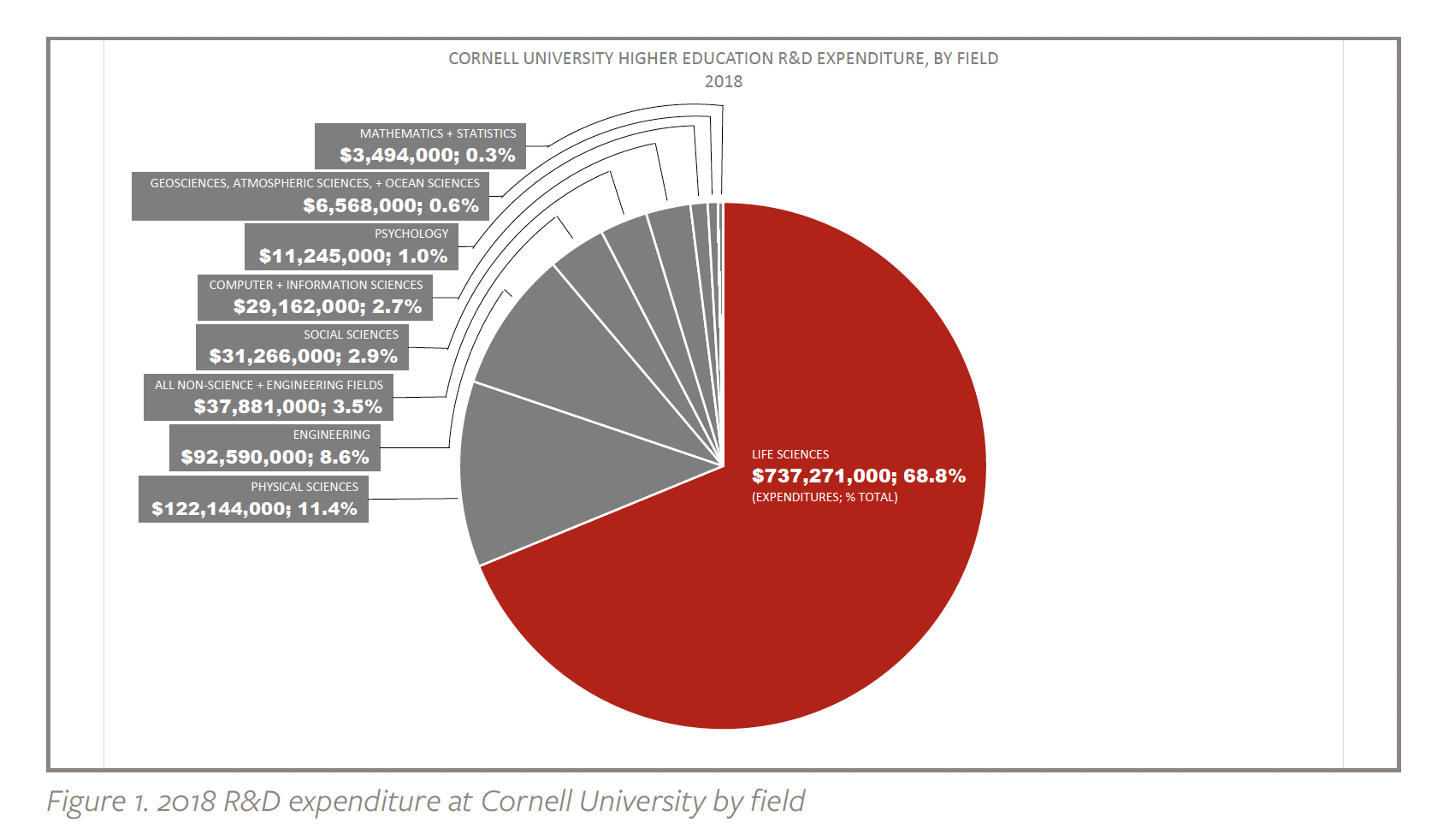Life Sciences at Cornell
The Life Sciences at Cornell University
The life sciences are dominant at major academic institutions across the country, including biological and biomedical sciences, clinical research, engineering, and veterinary medicine. As federal funding for life sciences has grown, the field has emerged to present a wealth of opportunities for researchers and innovators on academic campuses today.1
Cornell University is no outlier. In 2018, the university spent 69% of its R&D budget on the life sciences, totaling $737 million. Universities play a central role in harnessing such funding to produce and translate fundamental and applied research into life sciences innovation. In 2018, universities nationwide collectively spent nearly $46 billion on life sciences R&D (about 58% of all academic R&D spending in the U.S.), the vast majority of that money went to health sciences and biological and biomedical sciences.2 No other field is comparable. The next closest field is engineering which received $12 billion in R&D investment in 2018. Top academic spenders on life sciences R&D include the University of California, San Francisco ($1.5 billion), Johns Hopkins University ($1.07 billion), University of Michigan ($873 million), University of Pittsburgh ($863 million), and Cornell University ($737 million). By supplying a critical mass of researchers and infrastructure to conduct life sciences research, these universities act as anchors for the federal government to direct funding toward the development of life sciences innovation clusters on their campuses, and in their communities.
Cornell leads New York State in training researchers and entrepreneurs in the life sciences. Cornell’s doctoral programs in the life sciences award the most earned doctorates of any field at the university, comprising 24.1% of all doctoral degrees in 2018, and enroll the most full-time doctoral students in the life sciences in the state.6 Programs like the Kevin M. McGovern Family Center for Venture Development in the Life Sciences, the College of Engineering Commercialization Fellowship, and the Upstate New York I-Corps Node have directed millions of dollars in funding and investment towards the translation of fundamental and applied research on campus into new businesses and jobs in the regional economy.
Life Science R&D at Cornell by the Numbers
Cornell’s R&D expenditure in the life sciences is over six times larger than the expenditure of the next largest field, the physical sciences, which measures at about $122 million.7

Within the National Science Foundation’s classifications, R&D expenditure in the life sciences is categorized into four subfields: biological and biomedical sciences, health sciences, agricultural sciences, and natural resources and conservation. At Cornell, the health sciences rank first among life sciences subfields with nearly $310 million in expenditure, and the biological and biomedical sciences rank second with $298 million in expenditure. Together, these two subfields comprise 82.4% of all life sciences R&D expenditure at the university (Fig.2).

Higher education R&D expenditure is categorized according to the following funding sources: federal agencies, state and local government, institution funds, business, and nonprofit organizations. About half of Cornell’s research funding comes from the federal government, of which 74% ($206 million) comes from National Institute of Health (NIH) grants. That $206 million from the federal government represents about a third of all life sciences research spending at Cornell, meaning the university itself invests heavily in fundamental and applied research in the life sciences.

Cornell continues to pioneer cutting-edge life sciences research through initiatives spanning its disciplines and campuses, addressing the pressing need for innovation in the health, biological, and agricultural sciences through strategic radical collaboration (see box for more detail). By leveraging its specialized facilities and skilled workforce, Cornell channels significant funding from the federal government into New York State for life sciences R&D. Cornell actively works to translate the fundamental and applied research produced on its campuses into innovations to spur the development of regional advanced STEM economies statewide through entrepreneurship efforts like those at Cornell’s Center for Regional Economic Advancement and the UNY I-Corps Node. Together, these processes of research and innovation form a powerful and productive relationship that reinforces Cornell’s commitment to enhancing the lives of students and citizens on its campuses and beyond.
About CREA
The Center for Regional Economic Advancement fuels economic growth and diversity in Upstate New York through entrepreneurship and innovation. We support and empower people to to start and grow new ventures.
Contact
Research contributed by Adi Menayang and Sam Coons. Contact Christine Mehta at crea-research@cornell.edu with questions or more information.
Resources:
- Federal funding for life sciences research and development (R&D) has grown steadily over the past two decades, following a Congressional mandate doubling the National Institute of Health (NIH) budget from 1998 to 2003, and increases to the NIH’s budget during the Obama Administration. See here for more: Congressional Research Service, 2019, https://crsreports. congress.gov/product/pdf/R/R41705. In 2017, 70% of all federal life sciences R&D funding came from NIH grants. The federal government funded just over half of R&D spending at universities in 2018. CREA analysis of HHS TAGGS data and National Science Foundation Federal Funds for R&D data.
- CREA analysis of National Science Foundation Higher Education Research & Development data
- Our History: Founded in agriculture, focused on life,” Cornell University College of Agriculture and Life Sciences, https:// cals.cornell.edu/about/our-values-impact/our-history
- Cornell Life Sciences Task Force, “Executive Summary,” 2009, https://statements.cornell.edu/2009/document_archive/lifesci-summary-1109_remediated.pdf
- Cornell Office of the Provost, “Radical Collaboration Drives Discovery,” http://provost.cornell.edu/academic-initiatives/radical-collaboration/
- CREA analysis of National Science Foundation Survey of Earned Doctorates data.
- Weill Cornell Medicine accounts for $420,377,000 in medical school expenditures, which comprises 39.2% of the university’s total R&D expenditure and overlaps significantly with its expenditure in the life sciences
- FY2018 HHS awards for Cornell University and Weill Cornell Medicine, TAGGS Recipient Search, https://taggs.hhs.gov/ SearchRecip”https://taggs.hhs.gov/SearchReciphttps://taggs.hhs.gov/SearchRecip
